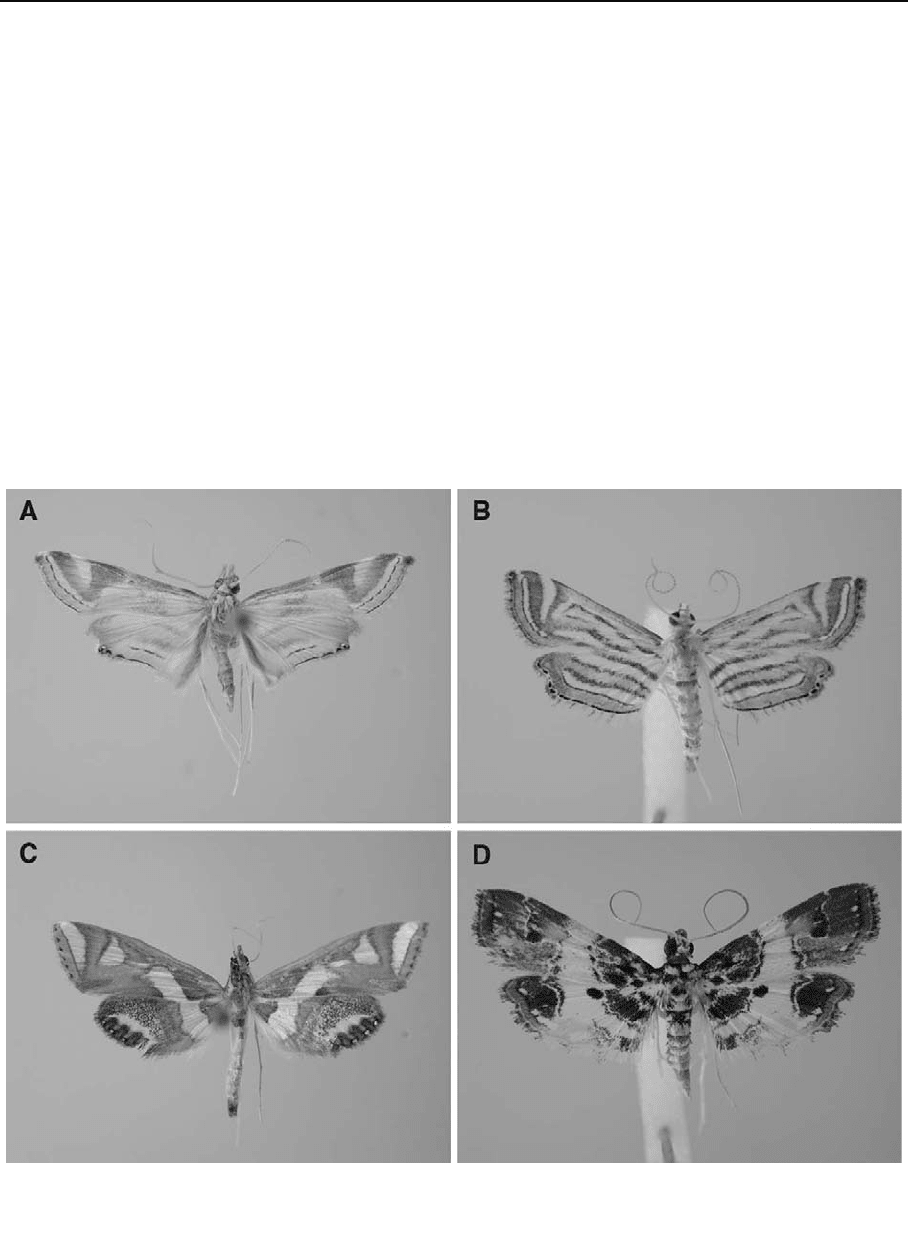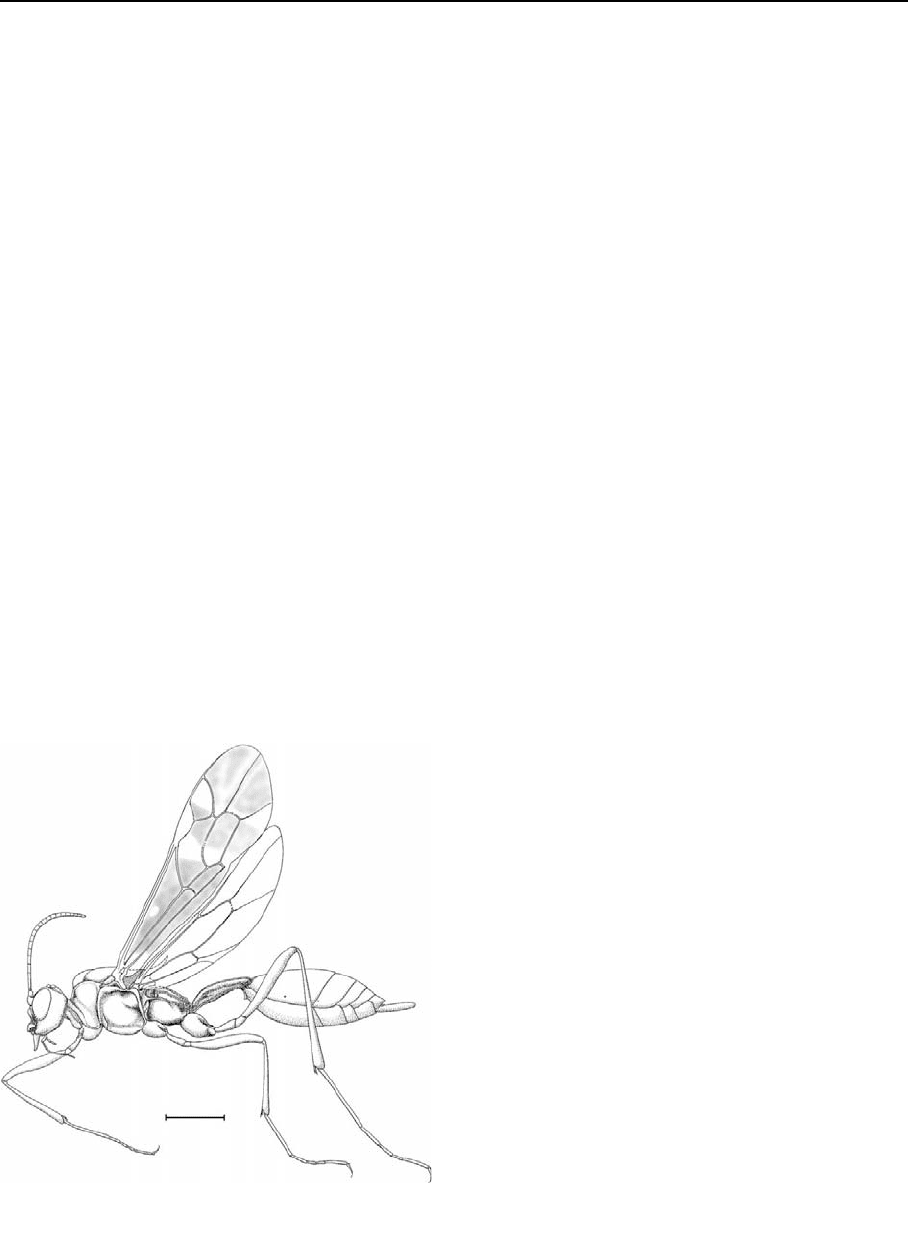Balian E.V., L?v?que C., Segers H., Martens K. (Eds.) Freshwater Animal Diversity Assessment
Подождите немного. Документ загружается.


FRESHWATER ANIMAL DIVERSITY ASSESSMENT
Global diversity of butterflies (Lepidotera)
in freshwater
Wolfram Mey Æ Wolfgang Speidel
Springer Science+Business Media B.V. 2007
Abstract In Lepidoptera, the subfamily Acentropi-
nae and Pyraustinae of Crambidae (Pyraloidea) and
the family Arctiidae (Noctuoidea) contain species
with true aquatic larvae, which live submerged during
larval development. In Pyraustinae and Arctiidae only
a few species exhibit an aquatic life-history. From the
latter, aquatic larvae are known from the Neotropical
genus Paracles. The number of aquatic Paracles
species is unknown. The Acentropinae are predomi-
nantly aquatic. They are distributed worldwide, and
reach the highest diversity in tropical regions of South
East Asia/Malesia and in the Neotropical Region. At
present, the Acentropinae include a total of 50 genera
and 737 described species. All genera, assigned to the
subfamily, are listed in a table, and the numbers of
included species are indicated. The taxonomy and
phylogeney of the genera are inadequately known.
The species have a minor economic importance,
however, they are very sensitive to degradation of
water qual ity and habitat destruction.
Keywords Lepidoptera Acentropinae Pyraloidea
Arctiidae Diversity Distribution Taxonomy
Genera Species numbers
Introduction
For an outsider it is surprising to learn that there are
indeed some Lepidoptera which are aquatic. Even for
limnologists or aquatic entomologists aquatic moths
do not belong to the well known and instantly
recognised types of aquatic insects. There is a speci al
reason for the poor recognition of aquatic Lepidop-
tera: the handling of the adult moths during sampling
and processing differs com pletely from the methods
used for other freshwater insects. The wing patterns
provide features, which are diagnostic at the species
level and, therefore, must be preserved intact, i.e. in a
dry state. As a consequence, individuals have to be
treated very carefully . Correct handling needs to use
killing jars, pins, pinning boxes, setting boards, and
insect drawers. These tools do not belong to the
regular equipment of aquatic entomologists or lim-
nologists. However, they are regularly used by
lepidopterists, who are usually specialised on certain
families. The study of aquatic Lepidoptera has always
been a subject of lepidopterists alone, who on the
other side, however, rarely have a limnological
background.
Today, the accumulated knowledge on aquatic
species has a focus on adults and is scattered in the
Guest editors: E.V. Balian, C. Le
´
ve
ˆ
que, H. Segers &
K. Martens
Freshwater Animal Diversity Assessment
W. Mey (&)
Museum fu
¨
r Naturkunde, Humboldt-Universita
¨
t Berlin,
Invalidenstr. 43, 10115 Berlin, Germany
e-mail: wolfram.mey@museum.hu-berlin.de
W. Speidel
Museum Witt, Tengstrasse 33, 80796 Munchen, Germany
123
Hydrobiologia (2008) 595:521–528
DOI 10.1007/s10750-007-9038-9

vast Lepidoptera literature, which is not easily
accessible for limnologists. Data on larvae is limited.
The larvae are caterpillars with a small degree of
intrageneric morphological differentiation, which
makes the identification at the species level very
difficult or impossible. The genera and species of the
Holarctic Region are rather well known. But Holarc-
tic species make up only a minority of the world
fauna in contrast to the overwhelming diversity of
taxa present in the tropics. Many species were only
provisionally assigned to a genus and remained there
up to now. Several aquatic species are exceptional
cases within their systematic groups. However, there
is a group of Lepidoptera, whose larvae are almost
exclusively aquatic; these are the so-called China-
Mark-Moths (Pyraloidea: Acentropinae). The larval
stages of most tropical species are undescribed, but
might be expected as aquatic. Information on the
biology of immatures is very poor. At this stage,
available data on the distribution, phylogeny and
taxonomy of aquatic moths are much too incomplete
to embark seriously into a deeper analysis of the
group concerning historical biogeography, faunal
changes, centres of endemicity, etc. However, a
summary of the currently recognised taxa and their
distribution on the planet can be provided. The
present account concentrates on families, which have
true aquatic species, i.e., with submerged living
larvae. These are the families Crambidae (Pyraloidea)
and Arctiidae. Some further families contain semi-
aquatic species. They are not considered here.
Species and generic diversity
Family Arctiidae: Arctiinae
The subfamily includes about 3,600 species (Hepp-
ner, 1991). One species is well-known for its aquatic
caterpillars: Paracles laboulbeni (Bar, 1873). It was
formerly placed in the genus Palustra. The species is
widely distributed in the Neotropical Region. The
caterpillars feed on submerged plants in sta gnant or
slow flowing waters (Adis, 1983). They lack tracheal
gills. Respiration is mediated by air-holding hairs
forming a plastron on the dorsal side. The genus
Paracles is very speciose. It is unclear, whether P.
laboulbeni is the only aquatic species or whether
further congeners have aquatic immatures.
Family Crambidae: Pyraustinae
The subfamily is a mega-diverse group with over
7,000 species word-wide (Heppner, 1991), also
sometimes retained in a larger concept of Pyralidae.
A few species are reported to have aquatic larvae
(Buckingham, 1994):
Samea multiplicalis Guene
´
e, 1854—Neotropical
Region,
Niphograpta albiguttalis Warren, 1889—Neotrop-
ical Region.
Both species have been used in biological control
programme to suppress mass developments of aquatic
weeds in stagnant and running waters. In South–East
Asia there are several, hitherto unidentified species,
which were collected only close to running waters.
They form aggregations of adults on the underside of
boulders and overhanging rocks, a behaviour known
for aquatic moths. The larvae of these species are
supposed to be aquatic, but have not been traced yet.
Family Crambidae: Acentropinae
The group is well known under its synonymous name
Nymphulinae. Heppner (1991) has compiled species
totals for each of the over 300 subfamilies and
families of the Lepidoptera of the world. They were
tabulated according to major faunal regions whose
delimitations are essentially based on Darlington
(1957). According to his figures the Acentropinae
comprise 716 described species. During recent years
a number of new checklists, catalogues and taxo-
nomic change s were published, which provide
current figures for Acentropinae of nearly all faunal
regions or continents: Henning (2003), Li et al.
(2003), Munroe (1983, 1995), Shaffer et al. (1996) ,
Speidel (2005), Speidel & Mey (1999), Yen (2004),
You et al. (2002). In addition, a large number of new
species have been described especially from the
Oriental Region in the last decade (Li et al., 2003;
Mey, 2006; Mey & Speidel, 2005; Speidel, 2003;
Yoshiyasu, 1987; You & Li, 2005; You et al., 2003,
etc.). Based on these publications and our own studies
a new synthesis was undertaken at the generic level.
We have used Heppner‘s scheme with slight changes:
the northern Mexican border line is the border of the
Neotropical Region and the Australian Region is
divided into a Newgui nean-Polynesian and proper
522 Hydrobiologia (2008) 595:521–528
123

Australian–New Zealand Region. The new figures are
summarised in Table 2. Up to date, the Acentropinae
encompass 737 species in 50 genera. Interestingly,
the counts are similar to Heppner‘s ones. In the past,
many more genera were included, mainly because of
superficial resemblance of wing patterns of the adults.
They has been subsequently excluded, but this
process is not complete. Exclusion of misplaced taxa
and synony mies have not equalled the number of new
species descriptions since 1991 (Figs. 1, 2).
The counts for the faunal regions are not by type
localities. Thus, the problem of double counting of
species which are distributed in several faunal regions
has to be considered. The problem is notoriously
evident in the East Palaearctic and Oriental Faunal
Regions, which have a broad, common transition
zone. Widespread species were indicated for all
faunal regions in which they occur, but recorded only
once in the ‘‘total’’ column of Table 2.
Phylogeny and historical processes
Lepidoptera are essentially terrestrial insects. Only a
tiny fraction of the 165,000 describ ed species can be
termed aquatic, which means that they have immature
stages that live under water. The adults are terrestrial as
in the majority of water insects. The conquest of the
aquatic environment by lepidopteran larvae is not that
astonishing as it may appear at first glance. Larvae of
Lepidoptera—the caterpillars—have an enormous
adaptive potential (Scoble, 1992). Primitive species
like Micropterigidae or ancestral Pyraloidea are detri-
tivorous and moss feeders sometimes are associated
Fig. 1 (A) Eoophyla boernickei Mey, 2006, male (Borneo), (B) Parapoynx leucographa Speidel, 2003, male (Borneo) (C)
Margarosticha spec., male (Sulawesi), (D) Paracymoriza spec., male (Borneo)
Hydrobiologia (2008) 595:521–528 523
123

with fungi or animal matter (Munroe & Solis, 1998:
235). The larvae often live in a humid environment on
the ground. With the development and radiation of the
angiosperms in the Cretaceous a new food resource
became widely available. Caterpillars of early evolu-
tionary lineages started to use green-plant tissue as a
food source and became phytophagous. In a process of
co-evolution and radiation together with the angio-
sperms, the Lepidoptera were able to adapt to all plant
groups and developed a wide array of life histories,
forms and strategies which allowed them to exploit all
parts of a plant: leaves, stems , roots, bark, twigs,
flowers, seeds, etc. Aquatic or semiaquatic plants,
being no excep tions, are hosts of a number of
lepidopteran species, too.
The caterpillars usually feed on green leaves or on
the periphyton in rocky habitats. The cuticule of
caterpillars has morphological preadaptions to some
kind of plastron respiration. With these larval
preadaptions it was only a small step in the evolution
from a wet terrestrial to a semiaquatic life history. It
is, therefore, not surprising that a transition to aquatic
or semiaquatic life occurred several times and
independently in different, unrelated taxa of Lepi-
doptera. Aquatic larvae are known to occur in the
mega-diverse families Crambidae and Arctiidae
(Table 1). There are probably more families with
aquatic representatives. The poor exploration and
knowledge of tropical Lepidoptera, especially of rain
forest areas with their huge variety of aquatic habitats
Fig. 2 Distribution of freshwater Lepidoptera species and genera by zoogeographical region (species number/genus number). PA—
Palaearctic; NA—Nearctic; NT—Neotropical; AT—Afrotropical; OL—Oriental; AU—Australasian; PAC—Pacific Oceanic Islands
Table 1 Generic and
species diversity of
currently known
Lepidoptera taxa with
aquatic larvae
Superfamily/Family Subfamily Number of genera Number of species
Pyraloidea
Crambidae Acentropinae 50 737
Pyraustinae 2 2
Noctuidoidea
Arctiidae Arctiinae 1 1
524 Hydrobiologia (2008) 595:521–528
123

Table 2 The genera of Acentropinae—their distribution
and diversity in the major Biogeographical Regions of the
world (PA = Palaearctic, NA = Nearctic, NT = Neotropical,
AT = Afrotropical, OL = Oriental, AU = Australasian, PAC =
Pacific Oceanic Islands (Micronesia-Polynesia))
Genus PA NA NT AT OL AU PAc Total
Acentria Stephens, 1829 1 1 1
Agassiziella Yoshiyasu, 1989 2 10 12
Ambia Walker, 1859* 7* 7
Anydraula Meyrick, 1885 2 3* 5
Araeomorpha Turner, 1908 2 2
Argyractis Hampson, 1897 1 12 8* 21
Argyractoides Lange, 1956 12 12
Argyrophorodes Marion, 1957* 7* 7
Aulacodes Guene
´
e, 1854 35 3 38
Callilitha Munroe, 1959 22
Cataclysta Hu
¨
bner, [1825] 1 9* 9* 2* 21
Chrysendeton Grote, 1881 3 16 19
Cryptocosma Lederer, 1863 1 1
Contiger Lange, 1956 1 1
Elophila Hu
¨
bner, 1822 13 4 2 2 7* 6 31
Eoophyla Swinhoe, 1900 11 12* 54 73 142
Eoparargyractis Lange, 1956 3 3
Ephormotris Meyrick, 1933 2* 2 4
Eristena Warren, 1896 12 26 3* 41
Giorgia Clarke, 1965 1 1
Hemiloba Swinhoe, 1901 1 1
Hygraula Meyrick, 1885 2 2
Hylebatis Turner, 1908 11
Kasania Krulikowsky, 1910 1 1
Langessa Munroe 1972 1 1
Lathroteles Clarke, 1971* 1* 1
Margarosticha Lederer, 1863 2 13 15
Neargyractis Lange, 1956 1 7 8
Neocataclysta Lange, 1956 1 1
Neoschoenobia Hampson, 1900 1 1 2
Nyctiplanes Turner, 1937 1 1
Nymphicula Snellen, 1880 7 10* 22 7 46
Nymphula Schrank, 1802 4 1 2 2* 9
Nymphuliella Lange, 1956 1 1
Nymphulodes Hampson, 1919 1 1
Oligostigma Guene
´
e, 1854 7 2* 2* 11
Oligostigmoides Lange, 1956 1 5 6
Oxyelophila Forbes, 1922 1 7 8
Paracataclysta Yoshiyasu, 1983 1* 1 1 3
Paracymoriza Warren, 1890 11* 22* 4* 37
Parapoynx
Hu
¨
bner,
[1825] 17
8 13 9* 16 22 76
Petrophila Guilding, 1830 15 82 97
Potamomusa Yoshiyasu, 1985 2 2
Hydrobiologia (2008) 595:521–528 525
123

suggests that we can expect further families with
aquatic members.
The most advanced adaptations to an aquatic
existence can be found in the pyraloid subfamily
Acentropinae (=Nymphulinae). The majority of
aquatic species belong to this subfamily. Hasenfuss
(1991) published a convincing scenario for the
evolution of the aquatic habit of Acentropinae.
According to the plant species or food resource, the
caterpillars developed a wide spectrum of adaptations
towards a semiaquatic and finally towards a fully
aquatic life: species wi th plastron respiration and
open tracheal system feed on floating or partly
submerged leaves, whereas species with tracheal
gills and closed spiracles are able to live on fully
submerged plants or are rock-dwellers in streams. A
comparative, taxonomic analysis of the genera on a
world-wide scale was not attempted so far, and thus,
makes the validity of some taxa questionable. Phy-
logenetic relations hips among genera were studied
only on a restricted geographical scale (cf. Speidel,
1984, 2005; Yoshiyasu, 1985). A subdivision of the
subfamily into two tribes was proposed by Lange
(1956). He included in Nymphulini the case-making
shredders and green-plant tissue feeders, and in
Argyractini the free living scrapers and web spinning
algae feeders. The division, however, was not found
to be an adequate reflection of phylogenetic relation-
ships (Munroe & Solis, 1998) and, thus, is not
followed here. Consequently, the genera are listed
alphabetically in Table 2.
The sister group relationship of the Acentropinae
is unresolved (Solis & Maes, 2002). Traditionally,
Acentropinae and Schoenobiinae have been consid-
ered closely related (Speidel, 1984; Munroe & Solis,
1998). They have semiaquatic larvae, which usually
feed as internal borers in the stems of water
monocots. Species of both subfamilies often occur
together in a wide range of aquatic habitats.
Present distribution and main areas of endemicity
As mentioned in the introduction, our inadequate
knowledge only allows rough conclusions from the
numbers in Table 2. The data show that tropical
regions have many more species than other faunal
regions. With approximately 40% of the world total
of described species, the peak diversity is in
Malesia, including the Pacific islands from Micro-
nesia to Polynesia. This is mainly due to the
radiation of the genus Eoophyla in maritime South
East Asia and, even more pronounced, in New
Guinea. More than 140 Acentropinae species are
endemic to this islands and the Wallacea, which had
to be included into the Australian Region here in
Table 2. Eoophyla is the largest group in Acentrop-
inae. It is rather homogeneous but includes some
isolated forms that may necessitate the establishment
of separate genera. A comparably large genus in the
Neotropical Region is Petrophila, which also gets
into the Nearctic. It makes up nearly 50% of all
Neotropical species. In contrast to Eoophyla, the
radiation of Petrophila developed in a continental
setting. The poor figures for tropical Africa are in
accordance with figures from other Lepidoptera
groups. However, Africa south of the Sahara,
including Madagascar, is a poorly sampled continent
and should contain many more species. There are
two genera which occur in all faunal regi ons:
Table 2 continued
Genus PA NA NT AT OL AU PAc Total
Pseudolithosia Hampson, 1907 1 1
Strepsinoma Meyrick, 1897 2 9 11
Synclita Lederer, 1863 4 3 7
Synclitodes Munroe, 1974 1 1
Tetrernia Meyrick, 1890 1 1
Thysanoidma Hampson, 1891 2 2
Usingeriessa Lange, 1956 2 10 12
Number of genera 12 17 18 11 14 21 4 50
Number of species 81 49 216 64 169 170 9 737
Numbers with * denote unclear generic or subfamily associations
526 Hydrobiologia (2008) 595:521–528
123

Elophila and Parapoy nx. Their species are mainly
inhabitants of stagnant waters.
Most genera have ranges restricted to one conti-
nent or to a single faunal region. The high number of
generic taxa in the New World and Australia appears
to demonstrate a higher diversity of evolutionary
lines on these continents. This can be genuine or is
merely an artifact due to the poor systematic inves-
tigation of the Afrotropical and Oriental faunas.
Human related issues
In general, aquatic moths are of little economic
importance. A few species are known to damage rice
in Asian countries: Parapoynx fluctuosalis (Guene
´
e,
1854), P. vittalis (Bremer, 1864) and P. stagnalis
(Zeller, 1852). Sometimes the injury can be serious,
but usually remains localised. The species are clearly
of less importance than rice stem borers of the
subfamily Schoenobiinae. The species from rice
paddies have a wide distribution. Some tropical
species were incidentally introduced together with
aquatic plants to other continents. In temperate
countries they are unable to adapt to the low winter
temperatures, and remain minor pests in greenhouses.
In warmer regions, some species have managed to
establish permanent populations in the field. The
phytophageous caterpillars have been regarded as a
promising means for the biologi cal control of aquatic
weeds. They have been successfully used in the
suppression of Hydrillia and Elodea in Florida
(Buckingham, 1994).
Acentropine species from running waters are very
susceptible to water pollution and water channel
regulations. They are among the first organisms
which would disappear when facing a drop in water
quality.
References
Adis, J., 1983. Eco-entomological observations from the
Amazon IV. Occurrence and feeding habits of the aquatic
caterpillar Palustra laboulbeni Bar, 1873 (Lepidoptera:
Arctiidae) in the vicinity of Manaus, Brazil. Acta
Amazonica 13: 31–36.
Buckingham, G. R., 1994. Biological control of aquatic weeds.
In Rosen, D., Bennett, F. D. & Capinera, J. L. (eds), Pest
Management in the Subtropics: Biological Control—a
Florida Perspective. Intercept Ltd, Andover, 737.
Darlington, P. J. Jr., 1957. Zoogeography: The geographic
distribution of animals. Wiley, New York, 675.
Hasenfuss, I., 1991. Evolution der aquatischen Larven und
Puppen der Acentropinae (=Nymphulinae/Crambidae/
Pyraloidea/Lep.). Verhandlungen der Deutschen Zoolog-
ischen Gesellschaft 84: 444.
Henning, S. F., 2003. Lepidoptera. In de Moor, I. J., J. A. Day
& F. C. de Moor (eds), Guides to the freshwater inver-
tebrates of Southern Africa, Vol. 8: Insecta III, 209.
Heppner, J. B., 1991. Faunal regions and the diversity of
Lepidoptera. Tropical Lepidoptera 2 supplement, 1: 85.
Li, Hou-Hun, P. You & S.-X. Wang, 2003. A systematic
study of the genus Eoophyla Swinhoe in China, with
descriptions of two new species (Lepidoptera, Crambi-
dae, Nymphulinae). Acta Zootaxonomica Sinica 28:
295–301.
Lange, H. W., 1956. A generic revision of the aquatic moths of
North America (Lepidoptera: Pyralidae, Nymphulinae).
The Wasmann Journal of Biology 14(1): 59–144.
Mey, W., 2006. Eine neue Art der Gattung Eoophyla Swinhoe,
1900 von Borneo (Lepidoptera: Crambidae, Acentropi-
nae). Entomologische Zeitschrift (Stuttgart) 116(2):
91–93.
Mey, W. & W. Speidel, 2005. Two new species of Eoophyla
Swinhoe, 1900 from continental South East Asia (Lepi-
doptera: Crambidae, Acentropinae). Bonner zoologische
Beitra
¨
ge 53(1/2), 115–119.
Munroe, E., 1983. Pyralidae. In Hodges, R. W. (ed), Check List
of the Lepidoptera of America North of Mexico. E.W.
Classey Ltd., London, xxiv + 284.
Munroe, E., 1995. Nymphulinae. In Heppner, J. B. (ed), Atlas
of Neotropical Lepidoptera. Checklist: part 2, Gainesville,
liv + 243.
Munroe, E. & A. M. Solis, 1998. The Pyraloidea. In Kristen-
sen, N.P. (ed), Lepidoptera, Moths and Butterflie
Handbuch der Zoologie, Bd. 4, 35, Vol. 1. Handbuch der
Zoologie, Bd. 4, 35, de Gruyter, Berlin, 487.
Scoble, M. J., 1992. The Lepidoptera—form, function and
diversity. The Natural History Museum, London.
Shaffer, M., E. S. Nielsen & M. Horak, 1996. Pyraloidea. In
Nielsen, E. S., Edwards, E. D. & Rangsi, T. V. (eds),
Checklist of the Lepidoptera of Australia.—Monographs
on Australian Lepidoptera, Vol. 4. CSIRO, Canberra,
xiv + 529.
Solis, A. M. & K. V. N. Maes, 2002. Preliminary phylogenetic
analysis of the subfamilies of Crambidae (Pyraloidea,
Lepidoptera). Belgian Journal of Entomology 4: 53–95.
Speidel, W., 1984. Revision der Acentropinae des palaeark-
tischen Faunengebietes (Lepidoptera: Crambidae). Neue
entomologische Nachrichten 12: 157 pp.
Speidel, W., 2003. New species of aquatic moths from the
Philippines (Lepidoptera, Crambidae). Insecta Koreana
20: 7–49.
Speidel, W., 2005. Acentropinae. In Huemer, P. & Karsholt, O.
(eds), Microlepidoptera of Europe, Vol. 4: 33–68.
Speidel, W. & W. Mey, 1999. Catalogue of the Oriental
Acentropinae (Lepidoptera, Crambidae). Tijdschrift voor
Entomologie 142: 125–142.
Hydrobiologia (2008) 595:521–528 527
123

Yen, S.-H., 2004. Insecta: Lepidoptera, Cram bidae, Acen-
tropinae. In Yule, C. M. & Seng, Yong-Hoi (eds),
Freshwater Invertebrates of the Malaysian Region.
Academy of Sciences Malaysia, Kuala Lumpur, 861.
Yoshiyasu, Y., 1985. A systematic study of the Nymphulinae
and the Musotiminae of Japan (Lepidoptera: Pyralidae).
Scientific Report of the Kyoto Prefectural University 37:
162 pp.
Yoshiyasu, Y., 1987. The Nymphulinae (Lepidoptera: Pyrali-
dae) from Thailand, with descriptions of a new genus and
six new species. Microlepidoptera of Thailand 1: 133–
184.
You, P., H.-H. Li & K.-L. Chen, 2002. Catalogue of the
Nymphulinae and Musotiminae of China (Lepidoptera:
Crambidae). In Zhang, Z.-Q. (ed), Fauna of China, Vol. 4:
37–64.
You, P., H.-H. Li & S.-X. Wang, 2003. A taxonomic study of
the genus Eristena Warren, 1896 from China (Lepidop-
tera, Crambidae, Nymphulinae). Acta Zootaxonomica
Sinica 28(2): 302–306.
You, P. & H.-H. Li, 2005. Two new species of Nymphulinae
(Lepidoptera: Crambidae) from China. Entomotaxonomia
27(2): 131–134.
528 Hydrobiologia (2008) 595:521–528
123

FRESHWATER ANIMAL DIVERSITY ASSESSMENT
Global diversity of hymenopterans (Hymenoptera; Insecta)
in freshwater
Andrew M. R. Bennett
Springer Science+Business Media B.V. 2007
Abstract A summary of the known species of
aquatic Hymenoptera is presented. In total, 150
species from 11 families are recognized as aquatic
(0.13% of the total described species). This number is
likely an underestimate, because of the high percent-
age of undescribed species and a lack of knowledge
of host range and behaviour for most species. All
aquatic Hymenoptera are parasitoids. Many species
have relatively dense pubescence to trap air and
elongate, tarsal claws to grip the substrate, when
underwater. Most species are known from the Hol-
arctic and Oriental regions, but this is likely an
artefact caused by lack of knowledge of other regions
of the world. Aquatic behaviour has evolved inde-
pendently at least 50 times within the order.
Keywords Global diversity Aquatic Hymenoptera
Introduction
The order Hymenoptera includes such well-known
insects as ants, bees and wasps. Hymenopterans
undergo complete metamorphosis and most species
may be recognized by possession of four membra-
nous wings (Fig. 1) coupled together with a series of
hook-like hairs known as hamuli (Goulet & Huber,
1993). The plesiomorphic biological condition is
herbivory (most sawflies) with transitions to parasi-
toidism and predation in more derived groups. Most
hymenopterans are parasitoids that develop in or on
one host arthropod, killing the host in the process
(Waage & Greathead, 1986). Some parasitoid species
parasitize eggs or pupae, but most oviposit in or on
host larvae.
Whereas almost all hymenopterans are terrestrial,
development in water has evolved independently in at
least 11 families (Table 1). All know n aquatic
Hymenoptera are parasitoids. A conservative ap-
proach has been adopted in this chapter such that only
species for which unequivocal evidence exists that
they spend at least some of their life in water are
included. This includes species in which female
adults enter the water to search for hosts, those with
endoparasitoid larvae inside aquatic larval hosts
(even if oviposition is terrestrial); and those in which
freshly eclosed adults must travel to the water’s
surface following pupation (even if they develop
inside stems of emergent vegetation). Only described
species with known hosts are included, except for a
few described species that lack host records, but
belong to genera that are unquestionably monophy-
letic and have a clear host range that includes only
aquatic hosts. Parasitoids that develop exclusively on
Guest editors: E. V. Balian, C. Le
´
ve
ˆ
que, H. Segers & K.
Martens
Freshwater Animal Diversity Assessment
A. M. R. Bennett (&)
Canadian National Collection of Insects, Agriculture
Canada, 960 Carling Ave., Ottawa, ON, Canada, K1A 0C6
e-mail: bennetta@agr.gc.ca
123
Hydrobiologia (2008) 595:529–534
DOI 10.1007/s10750-007-9036-y

terrestrial stages of aquatic insects are excluded (e.g.
in pupae of whirligig beetles or spongilla-flies).
Species diversity
The order Hymenoptera has over 115,000 described
species (Gaston, 1993) and with estimates of one
million (Grissell, 1999; Ulrich, 1999) to 2.5 million
(Stork, 1996) total species, it may rival Coleoptera as
the most species-rich order. Table 1 includes 150
aquatic species (0.13% of all described speci es).
These figures have been compiled mainly from
discussions with colleagues, from databases (Noyes,
2002; Yu et al., 2005) and from surveys of aquatic
species for the Nearctic (Bennett, in press) and
Palaearctic (Hedqvist, 1978) regions. Accordingly,
most aquatic species in this chapter are Holarctic, but
this is likely an artefact caused by poor sampling in
other regions of the world and little or no knowledge
of biology for the vast majority of species. This lack
of knowledge makes it practically impossible to
predict how many species of aquatic Hymeno ptera
might exist, especially considering that many aquatic
species belong to genera that are predominantly
terrestrial (i.e. knowledge of biology at the generic
level does not always help predict existence of
aquatic species ). The use of water-filled yellow pan
traps placed around water or on emergent rocks in
water indicates that a great many more water-
dependent species may exist, but until host associa-
tions and/or observations of aquatic behaviour are
made, thes e species cannot be confirmed as truly
aquatic. The number of confirmed aquatic species and
genera in each biogeographic region are summarized
in Tables 1 and 2 and Fig. 2.
Aquatic Hymenoptera are known from six super-
families and 11 families (Table 1). The two largest
families, Ichneumonidae and Braconidae, have the
two greatest numbers of aquatic speci es: 39 and 26,
respectively. Within the Ichneumonidae, species in at
least five genera appear to be exclusively aquatic:
Agriotypus Curtis (Agriotypinae) on Trichoptera and
Rhachioplex Bischoff (Campopleginae), Pseude rip-
ternus Viereck and Tanychela Townes (both Cre-
mastinae) and Apsilops Fo
¨
rster (Cryptinae) on
Lepidoptera. The braconid genus Ademo n Haliday
(Opiinae) is almost exclusively associated with
Hydrellia spp. larvae in emergent vegetation. Next
in richness of aquatic species are two families of egg
parasitoids: Trichogrammatidae (22) and Scelionidae
(17). Centrobiopsis Girault, Hydrophylita Ghesquie
`
re
and Prestwichia Lubbock (Trichogrammatidae) have
only aquatic species and Pseudanteris Fouts, Thoron
Haliday, Thoronella Masner and Tiphodytes Bradley
(Scelionidae) are all aquatic. The remaining families
have 12 or fewer aquatic species recorded within
each of them. Caraphractus cinctus Walker (My-
maridae), a parasitoid of dytiscid beetle eggs, has
been studied extensively and is known to swim with
its wings and mate inside submerg ed eggs (Jackson,
1966), although both of these habits are unusual for
the order. Most aquatic femal e wasps walk along the
substrate when searching for aquatic hosts and mate
out of water. The four species of Aspidogyrus
Yoshimoto (Figitidae) are endemic to Hawai i and
parasitize fly larvae in str eams (Beardsley, 1992).
Finally, Anoplius depressipes Banks (Pompili dae) is
the only wasp known to parasitize ‘‘non-insects’’
(water-dwelling pissaurid spiders of the genus Dolo-
medes Latreille) and the only one known to move its
hosts to land prior to ovipo sition (Roble, 1985).
Aquatic Hymenoptera parasitize at least 25 insect
families in the orders Odonata, Hemiptera, Megalop-
tera, Coleoptera, Diptera, Lepidoptera and Trichop-
tera. No cases of aquatic hyperparasitism are yet
known. Most aquatic Hymenoptera have been
Fig. 1 Agriotypus gracilis Waterston (Hymenoptera: Ichneu-
monidae) female habitus. Scale bar = 1 mm
530 Hydrobiologia (2008) 595:529–534
123
